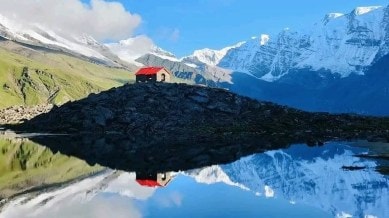Click here to join Express Pune WhatsApp channel and get a curated list of our stories
India’s glaciers can still be saved, says scientist
If, globally, temperatures are stabilized around 1.5° C, around 60 per cent of the glacier mass can be preserved until 2100 in India. But, if we reach around 3° Celsius of warming, it would be only around 40 per cent of the mass that remains in India until 2100

Even as countries around the world grapple with the loss of glacier mass due to global warming, a researcher from the University of Innsbruck, Austria, Lilian Schuster, gave a talk at the Indian Institute of Science Education and Research Pune on “Global multi-centennial mountain glacier response under a temperature overshoot”.
Speaking to The Indian Express after the event, Schuster said that India still has a lot of glaciers, in Ladakh and Jammu and Kashmir, among others, but could lose a lot of glacier mass unless emissions are reduced in future. “If, globally, temperatures are stabilized around 1.5° C, around 60 per cent of the glacier mass can be preserved until 2100 in India. But, if we reach around 3° Celsius of warming, it would be only around 40 per cent of the mass that remains in India until 2100. That’s quite a big difference,” said Schuster.
monthly limit of free stories.
with an Express account.
This is unlike Switzerland where, “no matter what we do, we will lose a lot of glacier mass”. This is, largely, because India has higher mountains and much more ice than those in Switzerland. Ladakh has a lot of small glaciers that are important for local communities, who depend on the run-off of small rivers. In the dry period, the melt water helps farmers in agriculture. “If these small glaciers disappear, we will see a change in the run-off regimes (ie, the seasonal pattern of water flowing from glacial areas into rivers and streams, among others),” says Schuster. With glaciers melting away, the whole landscape changes and affects biodiversity, community habits, cultural traditions, tourism and ways of life.
According to the United Nations, “The global average temperature for the most recent 10-year period, from 2014 to 2023, is estimated to be the warmest 10-year period on record, at around 1.2°C above the 1850-1900 average”. “We know that the temperature will increase in the future. We can’t stop the rise so fast. The question is, can we come back really fast? Can we reduce the emissions really, really fast? That has to be our aim, not only for glaciers but also for a lot of other things,” says Schuster.
She adds that almost all countries are not doing enough, with some countries doing even less than others. “As scientists, we can just try to communicate that we need to cut emissions as fast as possible because it will save a lot of lives and also a lot of money because adapting to events, such as sea level rise and rebuilding cities, will be extremely expensive,” she says. Schuster adds that she “never loses hope”. “Every tenth of a degree matters, and that’s what we really see for glaciers. The less warming we have, the more glacier mass we can preserve. We see that specifically for glaciers in the Indian Himalayas,” she adds.
Click here to join Express Pune WhatsApp channel and get a curated list of our stories